BTB Speaks to
Yesha Sant
Founded on the principles of integrity, patience, and purpose, Yesha Sant works closely with generational artisans to create garments that are as meaningful as they are meticulously made.

Written by: Manica Pathak
When a brand is conceived, there is always a traditional lingering pressure, to scale quickly, to grow fast, meet demands and prove success through the numbers. When Blur The Border spoke to Yesha Sant who founded her eponymous label 6 years ago, she recalls grappling with a similar tension during the early days, trying to build momentum while remaining true to the artisanal pace of handmade textiles that are the central to her brand’s identity, “Overtime, I have learned to not see those as obstacles, but rather a part of my brand’s identity,” she says. Having worked with traditional crafts such as Bandhani, Rabari prevalent in the Kutch region of Gujarat to create contemporary clothing, Yesha elaborates on the intricacies involved, “Working with natural dyes has a lot of limitations in terms of consistency, volume, and lead times. So, if a certain technique doesn’t allow for mass production, I would rather extend the timeline than compromise on the brand’s values. That also means things are slower, like the growth, and the production batches will be smaller. I have had to say no to a lot of opportunities simply because our timelines were longer. But it’s a choice I have made peace with,” she says. But this didn't come in the way of the brand’s website receiving consistent surges in traffic time and again. Yesha recalls one of the first such spikes, “We were completely overwhelmed. We didn’t have 2,000 or 3,000 pieces in stock, but the demand was for 7,000 through back-in-stock notifications, and all those pre-orders were sold out within just three days. The customer would receive their order two months later, and they were absolutely okay with that”
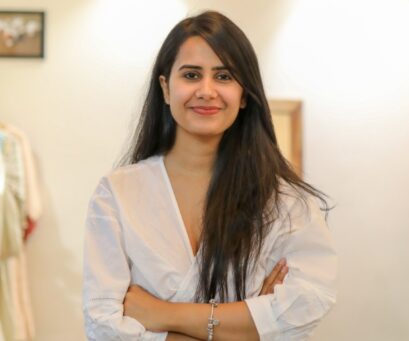
Yesha Sant
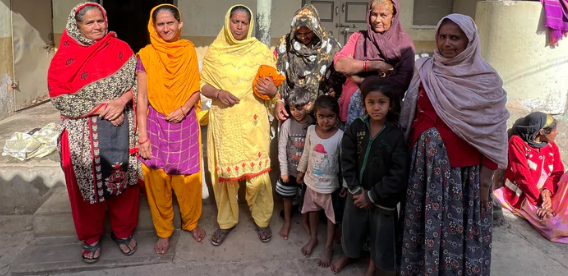
Bandhani artisans
But how does a culture dominated by instant gratification and rapid consumption create space to value the slower, more thoughtful processes of craftsmanship? “This wasn’t the case six years ago; people wouldn’t wait even seven days. But, when customers connect with the story behind a product—how it’s made, who made it, they are more patient. For example, every garment from our brand comes with a tag that says, “Who made your clothes?” It includes a photo of the weaver, their name, and on the back, a short story about the fabric and how it was created. Once we started sharing that on Instagram, the response was great, and the customers kept coming back. They didn’t mind the wait and are willing to understand how slow and intentional the process is,” she says and continues to add,” I think part of it is also the visibility. For instance, when Kareena Kapoor wore one of our pieces, it really boosted the trust and excitement.” While celebrity placement often acts as a powerful catalyst to brand visibility, for brands rooted in crafts, it can begin to spark a deeper cultural awareness. “It initiated conversations around handcrafted fashion. Many people didn't even know what Rabari was. But we make it a point to name our products with the craft and the community behind it. This way it also validates the artisans' work and the whole process behind each piece gets a moment in the spotlight,” says Yesha. She goes on to trace the story behind this particular, but though it’s worth noting that the journey truly began with the gap her label set out to bridge. “I noticed that some designers were simply sourcing shawls, fabrics, or embroidery patches from artisans and then using them in their garments without much thought. They were just lifted and pasted onto clothes. There was no narrative, no design story. I wanted to build something that would balance artisan involvement with thoughtful design, to reimagine these crafts rather than just replicate them, she says and continues, “I didn’t want to use traditional motifs in the same way. I wanted to take inspiration from things like their tattoos and reinterpret them into the designs. The Rabari women have tattoos all over their bodies, and each holds a symbolic meaning. We turned a few of them into hand-embroidered designs on the shirt, which later became one of our bestsellers,” says Yesha, adding that receiving messages from longtime customers and followers who instantly recognised the piece without any label or caption felt deeply gratifying. “That felt like home, like I have built something recognisable,” Yet, in the natural rhythm of highs and lows, it drew both positive recognition and critical feedback." Some people said things like, 'This is just Bandhani, it’s so cheap in Rajasthan.' But that’s the point. What we work with is crafted by the Rabari tribe, who have been practising this for five to six generations. It’s much less known and far more intricate than what’s widely available and easily accessible in the market."
“They are understandably very rooted in tradition. Design-wise, one of the biggest challenges was introducing a new color palette and reimagining motifs. For example, they typically mix two to three specific colors in a single dupatta, colors they have used for generations. But I began suggesting using a different, more contemporary palette and bringing new design ideas."
While creative freedom allows for reimagining crafts beyond their traditional forms, working with artisan clusters is far from a straightforward process, let alone simply walking into an artisanal cluster and instructing a design. “They are understandably very rooted in tradition. Design-wise, one of the biggest challenges was introducing a new color palette and reimagining motifs. For example, they typically mix two to three specific colors in a single dupatta, colors they have used for generations. But I began suggesting using a different, more contemporary palette and bringing new design ideas,” says Yesha, referring to the artisan clusters she had already worked with before, during her six-month internship at NIFT, who also currently form the foundation of her label. Even then, “It was hard for them to accept, and they didn't always agree; the artisans thought we were trying to alter their craft or compromise its authenticity.” But an idea with a strong sense of purpose is meant to lead somewhere meaningful, “It took time to build trust with around eight to nine months of observing and learning their techniques, visiting their homes, listening to their stories, and understanding their pace and approach to the craft—before I could properly start the brand. The goal was to help them see that we weren’t trying to change the essence of what they do, but rather to modernise it for today’s audience.” With time, things began shaping amicably. “Eventually, when they saw that there was demand for newer designs and color palettes, they were happy. It felt rewarding to see them embrace the change and feel confident in their work.”
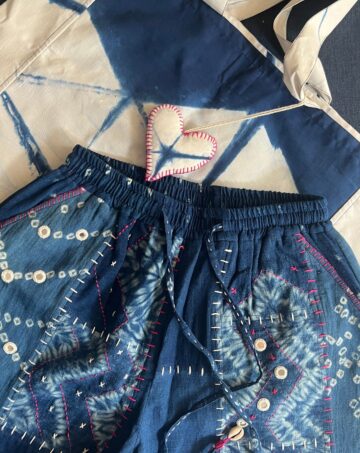
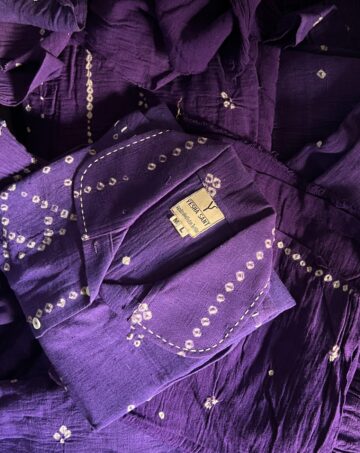
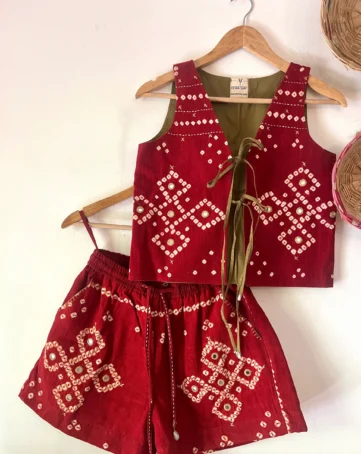
With that in mind, today, when Yesha travels to Kutch once a year for 15 days, it's more about nurturing a collaborative process together, “If I have an idea, I never impose it on them. I always ask, ‘What do you think about this?’ or ‘How can we adapt this?’ or ‘Is this possible with this fabric?’ Because honestly, sometimes a design looks great on paper but doesn’t translate well in silk—or it might not work with organic cotton. Involving their input is a key part of my design process. We work side by side, sampling extensively, and once we are satisfied, we move into production. I think they appreciate feeling heard—that we are not just using their craft, but actually involving them in the process.”
As next steps, Yesha set her sights on working with lesser-known crafts from Gujarat that aren’t getting the recognition they deserve, such as the Tangaliya weave. “It did quite well on our website, but scaling it was difficult. The weaver we were working with had two other jobs to sustain himself because Tangaliya alone wasn’t financially viable, including issues with timelines and availability.” Beyond logistical hurdles, the collaboration exposed a deeper tension—one that many brands grapple with, between staying rooted in their values and navigating the often harsh ground realities.“ I wanted to use organic cotton, but the weavers were mixing in synthetic threads because it was cheaper. That didn’t align with my brand values, so we had to drop it. We did try to work entirely with organic cotton, but it became too expensive for the weaver to sustain.”
So, it goes without question that while there’s been a welcome rise in appreciation for handwoven and artisanal textiles pioneered by homegrown brands, there’s a noticeable contrast in how traditional Indian crafts are valued at home versus abroad even today,” she explains. "When I have travelled to the US and Europe wearing my pieces, people often stop me and ask where the embroidery or fabric is from. I have found that international customers are patient and eager to understand the process, especially when they learn that the fabric is handwoven. They are also more willing to pay a fair price. But closer to home, the appreciation doesn’t run deep. I have seen people bargaining with weavers at Dastkar markets, and it’s disheartening. The same people wouldn’t bargain with a commercial fast-fashion brand, even though those products are mass-produced. I don’t understand the mindset of negotiating with a weaver who’s putting in weeks of work, but paying full price for a machine-made product. That attitude really needs to change." Further, the challenges of sustaining these crafts run much deeper than visibility or market demand. Behind the textiles and their detailed techniques lies an ecosystem that is fragile and under-supported. “As a small, independent designer, there's only so much I can do. We can place orders for a few meters, maybe 100 or 200, but that's not enough for the artisans to sustain their livelihoods,” Yesha elaborates on the sobering reality that despite the best intentions of independent designers, the scale and sustainability of craft revival often hit a wall—largely due to systemic gaps in policy and infrastructure. “This is where the government could step in with skill development initiatives, such as financial support, subsidies, and grants, especially to help artisans purchase quality raw materials or access training programs for both themselves and their children. These efforts could help sustain their crafts and livelihoods, as we are working with the last generation of weavers practising this craft. Their children have mostly moved on to other professions, and I don’t think the next generation even knows how to weave.”
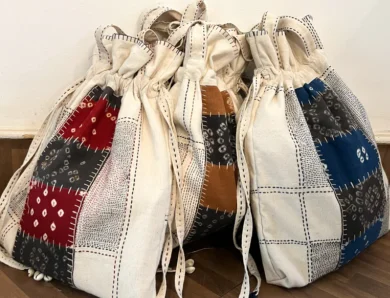

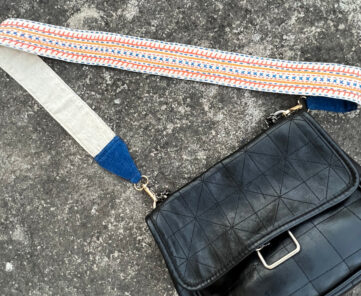
But on the brighter side, Yesha points to a positive development: “One positive initiative has been with the Handloom Mark. When I visited artisans, I saw that their products were tagged with this label, as well as the "ODOP" tag, One District, One Product.” She highlights ODOP as a flagship initiative by the Government of India aimed at identifying and promoting one unique product from each district across the country. Its goals include boosting local economies, supporting traditional and indigenous industries, improving market access for artisans and small producers, and generating employment opportunities. She adds, “While these initiatives help validate the authenticity of the product, they are still on a small scale. They need to be expanded through better funding and marketing support.”
While the growing call for greater government support continues, brands like Yesha Sant aren’t shying away from doing what they can to uplift artisans and preserve traditional crafts. “I want to deepen our impact, particularly by empowering women artisans. Right now, we are a team of twelve, and eleven of them are women, but I want to grow that number and build a stronger, more inclusive community of artisans.” As Yesha continues to strengthen the foundation of her brand locally, she’s also setting her sights on global expansion. The primary aim is to take the story of Indian craftsmanship to a wider audience.“ Our website is doing well, especially in the US and Europe, where people already shop with us. I'd also love to collaborate with retail stores internationally and position Yesha Sant in those markets.” And to further this, “We are collaborating with Flying Solo in New York to launch our next collection. It's on Fifth Avenue, so we are currently in the production phase. It’ll take about ten to eleven months to bring it to life,” she concludes.